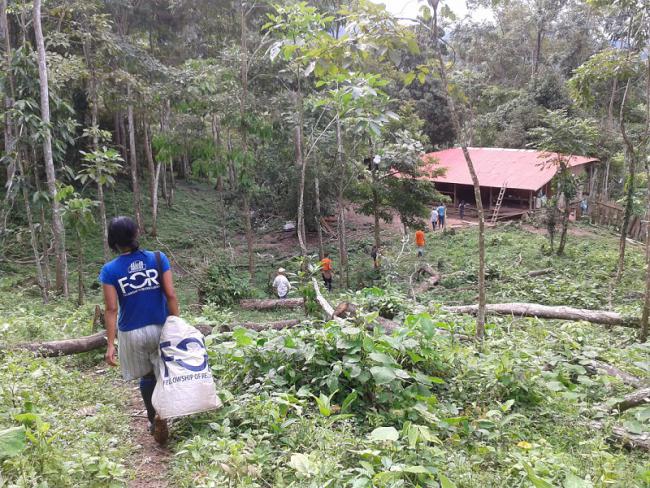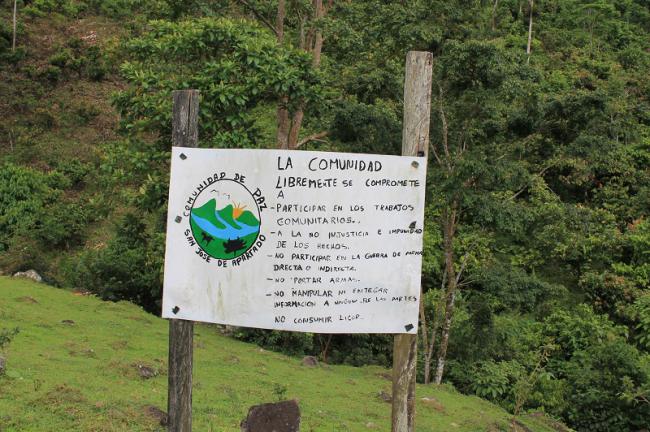 On September 23rd, members of the Peace Community of San José de Apartadó and a group of international accompaniers from For Peace Presence (FORPP) gathered after a long day of work in the mountains of Urabá. Together, they sat and listened to a historic announcement: the government of Colombia and the Revolutionary Armed Forces of Colombia (FARC) delegation in Havana had reached a tentative agreement on a peace accord, expected to be signed in the next six months. According to the terms of the agreement, the FARC insurgency will lay down their weapons and demobilize in the 60 days following the signing of the peace accord.
On September 23rd, members of the Peace Community of San José de Apartadó and a group of international accompaniers from For Peace Presence (FORPP) gathered after a long day of work in the mountains of Urabá. Together, they sat and listened to a historic announcement: the government of Colombia and the Revolutionary Armed Forces of Colombia (FARC) delegation in Havana had reached a tentative agreement on a peace accord, expected to be signed in the next six months. According to the terms of the agreement, the FARC insurgency will lay down their weapons and demobilize in the 60 days following the signing of the peace accord.
The announcement addressed one of the most difficult aspects of implementing a peace agreement in Colombia – justice. Under the terms of the proposal, a temporary, truth commission-like judicial body, the Special Jurisdiction for Peace, will be established, creating distinct categories of punishment for those who confess to crimes committed during the country’s long conflict, depending on the severity of the crimes committed. Excluding crimes against humanity and other serious war crimes, those who confess immediately will face the possibility of alternative sanctions, including supervised community work. Those who later recognize their responsibility will face five to eight years in prison, while those who deny their responsibility and are later convicted will face up to twenty years in prison. Some political crimes will be amnestied, though the details of what exactly will constitute such crimes have not yet been disclosed.
In the past, Colombia has undergone several failed peace processes, but the current talks between the government and the FARC have advanced further than any other attempt to end the FARC’s armed insurgency. With this breakthrough, agreements on four of the six major points of the current negotiations have been reached after three year of negotiations. This includes provisions on rural development reform, political participation of demilitarized guerillas, the illegal drug trade, and the matter of transitional justice. However, these points will only be implemented once a final peace deal has been signed. What remains to be negotiated are an agreement on victim compensation and an agreement on the end of the conflict, on implementation and verification. A national referendum will then be held to ratify the final accord.
The feelings of Colombians living in one of the most rural, militarized parts of the country are a lens into the cautious optimism present in the parts of Colombia that have been highly affected by the decades-long conflict. From the negotiating table in Havana to Bogotá to rural San José de Aparatadó, perspectives on peace vary widely.
The Peace Community of San José de Apartadó, located in the north of Urabá, Antioquia, was established in March 1997. It was formed in response to escalating violence in the area, as families from the settlements of San José de Apartadó were forced to leave due to threats from both the FARC and paramilitary groups, who often worked in conjunction with the Colombian military. Over time, the community organized, denounced the use of arms within their territories, and committed themselves to a variety of principles in the process, including cooperative communal work and a prohibition on the use of alcohol and the production of illicit drugs. The community has also refused to provide aid or information to armed actors. Since 2000, the Peace Community has been protected by provisional measures of the Inter-American Court of Human Rights (IACHR). Despite this, the residents in and around San José de Apartadó have continued to witness ongoing violence by legal and illegal armed actors; they’ve also been subject to threats and accusations by military forces. When the Peace Community organized to seek reconciliation with the government, they saw some of their leaders killed in violent massacres committed by paramilitaries. In 2000, for example, six community leaders were killed in La Unión after a paramilitary incursion, and in 2005, a community spokesperson was found brutally murdered alongside his family.
 For the Peace Community of San José de Apartadó, there is certainly reason to celebrate the possible end to an armed conflict that has lasted over 50 years, sacrificed the lives of many of their family members and leaders, and led to the forced internal displacement of their community multiple times over decades. Given its history and the community’s ongoing struggle for land, nothing could be more significant than bringing the country’s long civil war to an end. The Peace Community has proposed that the current peace negotiations would create humanitarian zones that both sides would respect. But there remain some concerns regarding the implementation of the peace agreement and its potential repercussions on the Peace Community’s life-sustaining territory. What will a post-agreement scenario look like for the community? How will civil society ratify the agreement? And what will peace mean for civilians who have lived in the middle of conflict-stricken areas, such as Urabá, for years?
For the Peace Community of San José de Apartadó, there is certainly reason to celebrate the possible end to an armed conflict that has lasted over 50 years, sacrificed the lives of many of their family members and leaders, and led to the forced internal displacement of their community multiple times over decades. Given its history and the community’s ongoing struggle for land, nothing could be more significant than bringing the country’s long civil war to an end. The Peace Community has proposed that the current peace negotiations would create humanitarian zones that both sides would respect. But there remain some concerns regarding the implementation of the peace agreement and its potential repercussions on the Peace Community’s life-sustaining territory. What will a post-agreement scenario look like for the community? How will civil society ratify the agreement? And what will peace mean for civilians who have lived in the middle of conflict-stricken areas, such as Urabá, for years?
In the Urabá region, threats by armed actors, including the Colombian military, paramilitary organizations, and guerillas have hung over the lives of local campesinos. The 2006 demobilization of the paramilitary group the United Self-Defense Forces of Colombia (AUC) did not eliminate paramilitary structures. Today, frequent conflicts continue between the National Police, the Colombian Military, the FARC, and Urabeños, a paramilitary group that operates in significant portions of the region. In the past two years, Colombian authorities and the media have pointed to allegations that the FARC fronts and paramilitary groups are collaborating in the cocaine drug trade. Such accusations resurfaced again last June when emails released by Colombian authorities revealed a close relationship between FARC and Urabeños leaders.
Despite continuous popular denunciations of the existence and threats of paramilitaries, as well as their links to local politicians and the local army, the government continues to deny the existence of paramilitaries and its links with the AUC, instead acknowledging only the existence of drug-trafficking criminal gangs.
Without effective mechanisms and opportunities to ensure that all armed actors disband, the demobilization of the FARC could lead to increased power for paramilitary groups. In short, paramilitary groups are in the position to fill the vacuum that an end to the FARC insurgency would leave behind. There could also be room for residual FARC combatants to either join paramilitary groups or form new armed groups in the region.
As in other parts of the country, an increase in paramilitary presence in territories traditionally controlled by the FARC has occurred in the Urabá region since they agreed to a unilateral ceasefire. In the early morning of November 11, for example, the paramilitary group Autodefensas Gaitanistas of Colombia entered one of the major settlements of the Peace Community and left pamphlets on community members’ doorsteps. This is troublesome not only because the territory of the Peace Community prohibits entry by armed actors, but also because similar incursions have been reported in various other settlements such as Mulatos, Arenas Altas, Arenas Bajas, and La Esperanza. Furthermore, news has circulated about the creation of paramilitary “black lists,” that threaten to murder civilians living in the zone.
Terrified inhabitants from various settlements of the region have begun to flee as a result of this increased paramilitary presence. According to a census by the Ombudsperson, more than 40 families were temporarily displaced to the settlement of La Esperanza after November 1st. With the signing of a peace accord near, the intensifying presence of paramilitaries is concerning, especially since the peace negotiations have so far not addressed the issue of if and how to dismantle the country’s paramilitary structures, despite the FARC peace delegation’s insistence that the matter be addressed.
A peace agreement could also entail more state control of territory formerly controlled by the FARC, and in turn, an increase in investment and infrastructure development — something that is already visible in the Urabá region, where new roads are now being constructed and major electricity projects have begun. Improvements in both infrastructure and the security situation are likely to attract foreign and national investment. If left unprotected, this could include the exploitation of the region’s fertile land, mineral and gas deposits, water, and timber resources. Such endeavors create additional threats to campesinos, the majority of whom depend on the region’s land and water for their own livelihoods.
The dangers posed by large-scale economic projects echo past traumas for Urabá’s campesino population, who have been forcibly displaced at the hands of large-scale agro industrial projects promoted by the government and implemented in close coordination with military and paramilitary groups.
For the Peace Community of San José de Apartadó, peace is much more than the end of the armed conflict; it represents campesinos’ ability to work their land in a self-sufficient manner. As one Peace Community member explained to us, when the people from the region were displaced, many left for the city. “They left not because there are more opportunities in the cities, but out of fear of violence, of armed groups,” he said. According to this individual’s assessment, the community would only know peace had arrived when those displaced to the cities were “no longer scared to return to the countryside and work their land.”
The implementation of a future peace accord in a region that has seen decades of conflict will require significant political will and assurances of good faith by all signing parties. History provides examples of wrong paths taken in the past. For the Peace Community of San José de Apartadó, the implementation of such agreements has always been difficult in practice. Trust and reconciliation cannot be expected overnight. And given the ongoing threats facing the community, it is understandable that the residents of San José de Apartadó continue to approach the hope of a future agreement with caution.
Laetitia Sengseis and Adilah Nasir are currently FOR Peace Presence international accompaniers of the Peace Community of San José de Apartadó. Sengseis has a Master’s degree in Public Policy from the Willy Brandt School of Public Policy in Erfut, Germany. Nasir holds an Advanced LL.M in Public International Law from Leiden University in the Netherlands. They can be contacted at sja@peacepresence.org.

